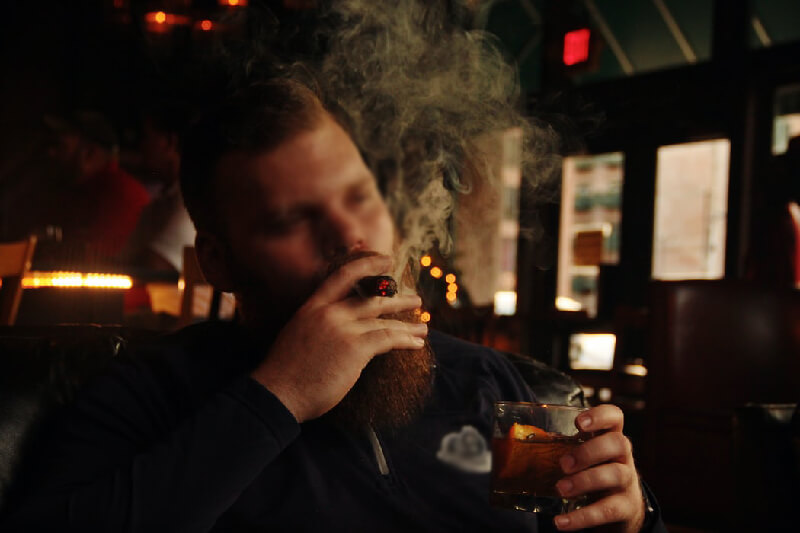WHO/Catharina de Kat-Reynen
Tobacco and alcohol-associated cancers can be prevented
by cost-effective policy measures
“This is not only a problem of public awareness, it is a sign that policies to prevent cancer across the WHO European Region can and should be bolder,” highlights Dr Nino Berdzuli, Director of the Division of Country Health Programmes.
Around 40% of cancers can be prevented, and public awareness of these 2 modifiable risk factors – tobacco and alcohol – needs to increase. Information about the health hazards linked to drinking alcohol and smoking should be combined with effective WHO-recommended health policies, which limit exposure to health-harming products as well as their affordability.
Cancer is the second-highest cause of morbidity and mortality in the Region, resulting in more than 3.7 million cases and 1.9 million deaths each year. In 2018, cancer caused 10 million deaths worldwide. Over the next 20 years, cancer rates are expected to rise by at least 60%.
Tobacco and cancer: non-smokers also at risk
Tobacco use accounts for 25% of all cancer deaths globally and is the primary cause of lung cancer. It remains a public health issue of the utmost importance in the Region, where an estimated 186 million people (or 26% of the adult population) currently use tobacco. For men, tobacco use is associated with 92% of trachea, bronchus and lung cancers; for women, this association rate is 62%.
People who use both alcohol and tobacco have a 5-fold increased risk of developing cancers of the oral cavity, oropharynx, larynx and oesophagus compared to people who use either alcohol or tobacco alone. For heavy users, the risk is up to 30 times higher.
Smokers are up to 22 times more likely to develop lung cancer in their lifetime compared to non-smokers. However, people who do not use tobacco but who are exposed to second-hand smoke at home, work or in other public places also have an increased risk of developing lung diseases, including chronic respiratory diseases and lung cancer.
The good news, however, is that lung cancer is largely preventable and almost 9 out of 10 cases can be prevented if current smokers quit. The benefits of quitting tobacco are almost immediate. After just 20 minutes of quitting smoking, heart rate drops. Within 2–12 weeks, circulation improves and lung function increases. Within 1–9 months, coughing and shortness of breath decrease. After 10 years of quitting smoking, the risk of lung cancer falls to about half that of a smoker.
These are undoubtedly strong arguments for making tobacco control a priority among the risk-factor reduction strategies for cancer.
Alcohol and cancer: no safe level
According to a recent factsheet produced by the WHO European Office for the Prevention and Control of Noncommunicable Diseases, in 2018 alone, around 180 000 cases of cancer and 92 000 cancer deaths were causally linked to alcohol in the Region.
There is no safe level of alcohol consumption – regardless of the type of beverage, its quality or price – because the primary compound that can cause cancer is alcohol itself.
Almost 11% of all cancer cases causally linked to alcohol across the Region in 2018 were due to drinking no more than 1 large bottle of beer (500 ml), 2 glasses of wine (200 ml) or 60 ml of spirits per day. Cancer risks start from the first gram of alcohol consumed and increase with the amount that people drink.
How countries can protect consumers’ health
All 53 countries of the WHO European Region have signed on to the European Programme of Work (2020–2025), a document that promotes united action for better health. It contributes to actions aimed at decreasing cancer morbidity and deaths.
“Well chosen public-health policy measures can raise public awareness and open new ways to protect consumers’ health,” explains Dr Berdzuli. “WHO-recommended ‘best-buy’ measures are cost-effective and easy to implement. They emphasize increasing taxes and prices for harmful products, enforcing marketing restrictions, and limiting their physical availability.”
WHO also strongly supports adding warnings on labels for health-harming products. As Dr Berdzuli notes, “Concentrating on preventable health risks is the fastest and easiest way to ensure the health and well-being of people in our Region.”









